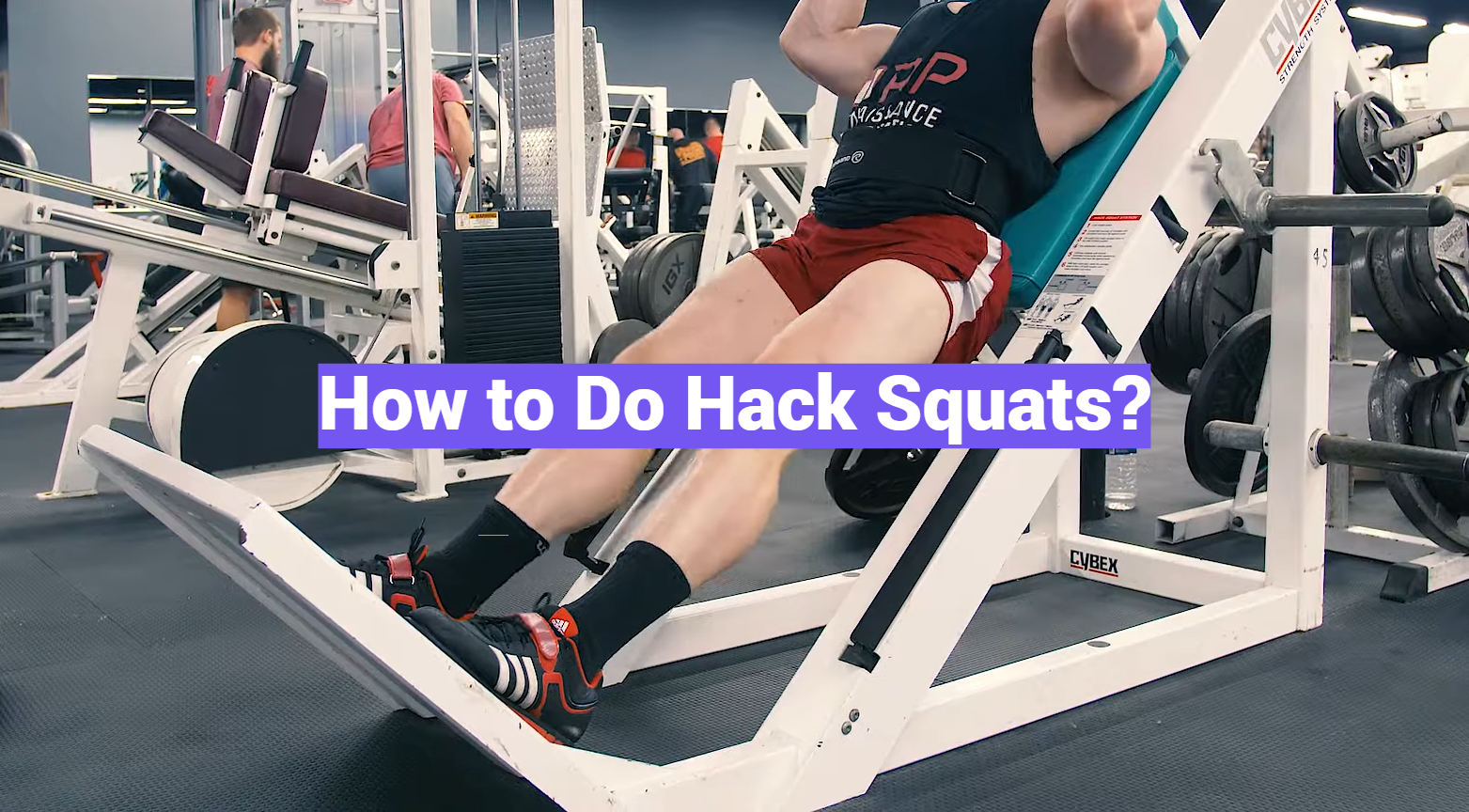With an impressive ability to target several muscle groups simultaneously, Hack Squats have become a staple in fitness enthusiasts’ workout routines worldwide. This potent exercise, named after bodybuilder and weightlifter George Hackenschmidt, primarily engages your quadriceps, hamstrings, and gluteus maximus, offering an effective strategy for building lower-body strength. Whether you’re a seasoned gym-goer or a fitness novice, understanding the correct form for Hack Squats can significantly enhance your workout efficacy and overall fitness progress.
What are Hack Squats?
Hack squats are a strength training exercise that primarily targets the muscles in your lower body, specifically the quadriceps, glutes, and hamstrings. This exercise is also known as machine hack squats because it typically requires a hack squat machine, but can also be performed with free weights or resistance bands.
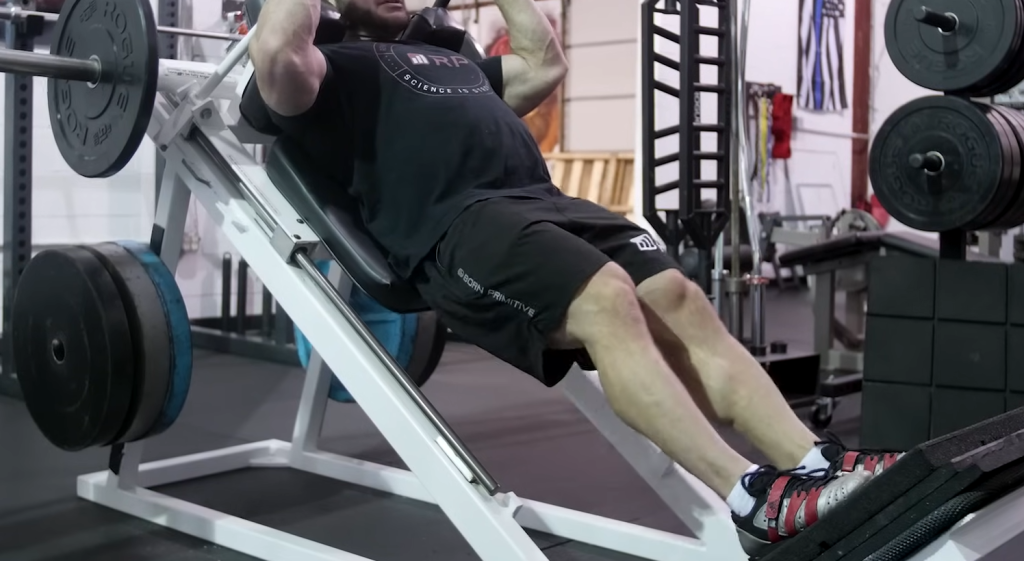
How to Perform Hack Squats?
- Begin by standing in front of the hack squat machine with your feet shoulder-width apart. Adjust the footplate so that it is at a comfortable height for your body.
- Step onto the footplate and position your feet shoulder-width apart in a slight outward angle. This will help target your inner thighs.
- Grasp onto the handles or sides of the machine for support, and slowly bend your knees and lower your body down into a squat position.
- Keep your back straight and your chest up, and make sure your knees do not extend beyond your toes.
- Once you have reached a 90-degree angle with your knees, push through your heels to return to the starting position.
- Repeat for the desired number of reps. [1]
Tips for Proper Form
- Keep your feet flat on the footplate and distribute your weight evenly.
- Engage your core muscles to help stabilize your body.
- Avoid locking your knees at the top of the movement.
- Do not let your knees cave inwards, keep them aligned with your toes.

Benefits of Hack Squats
- Stronger Lower Body:As mentioned earlier, hack squats target the major muscles in your lower body. Regularly performing this exercise can help increase strength and muscle mass in your glutes, quadriceps, and hamstrings.
- Improved Balance and Stability:Hack squats require you to stabilize your body while performing the movement, which can help improve balance and stability over time.
- Joint-Friendly Exercise:Unlike traditional barbell squats, hack squats put less strain on your lower back and knees. This makes it a suitable exercise for people with joint issues.
- Versatility:As mentioned earlier, hack squats can be performed using different equipment, making it a versatile exercise that can be incorporated into any workout routine.
Variations of Hack Squats
- Dumbbell Hack Squats:This variation can be done with dumbbells held at your sides instead of using the machine. This will also engage your core muscles for stability.
- Resistance Band Hack Squats:For those who do not have access to a hack squat machine, resistance bands can be used by attaching them to an anchor point and standing on the bands while performing the squat movement.
- Single-Leg Hack Squats:This variation requires you to perform the exercise with one leg at a time, which can help improve balance and stability even further.
Precautions for Doing Hack Squats
- Always start with a light weight and gradually increase as you become more comfortable with the movement.
- Avoid jerking or swinging your body while performing the exercise, as this can cause injury.
- If you experience any pain in your knees, lower back, or hips, stop immediately and consult a doctor. These could be signs of improper form or an underlying condition. [2]
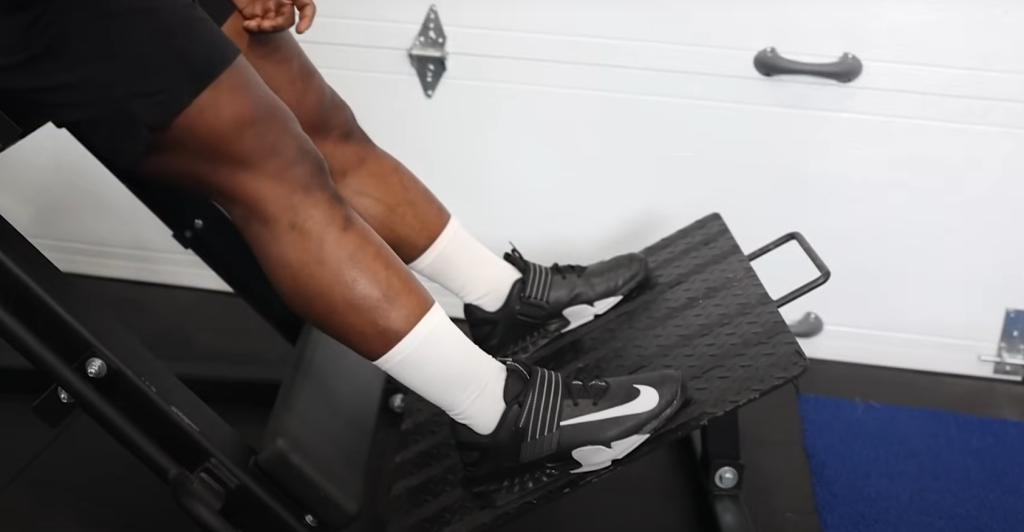
Tips for Doing Hack Squats
- Incorporate hack squats into your leg day routine at least once a week for optimal results.
- Vary the weight and number of reps to keep challenging your muscles and avoid plateauing.
- Don’t forget to warm up properly before performing hack squats to prevent injury. This can include dynamic stretches or using the hack squat machine without any weights.
Common Mistakes and Tips for Improvement
- Rounding your back: Make sure to keep your back straight and chest up throughout the entire movement. This will help engage your core muscles and prevent strain on your lower back.
- Not going deep enough:While it is important to not let your knees extend beyond your toes, make sure to squat down until your thighs are parallel to the ground. This will ensure that you are fully engaging your leg muscles.
- Using too much weight:It is important to start with a weight that challenges you but also allows you to maintain proper form. Using too much weight can lead to injury and prevent optimal muscle engagement.
- Neglecting other leg exercises:While hack squats are an effective lower body exercise, it is important to also incorporate other leg exercises into your routine for a well-rounded workout.
How to Do a Barbell Hack Squat in Five Simple Steps
- Begin by standing in front of a barbell with your feet shoulder-width apart.
- Reach down and grasp the bar with an overhand grip, hands slightly wider than shoulder-width apart.
- Lift the bar off the ground to rest on the back of your legs, just below your glutes.
- Keeping your back straight and chest up, squat down until your thighs are parallel to the ground.
- Push through your heels to return to the starting position. Repeat for the desired number of reps. [3]
Muscles Worked During Hack Squats
- Quadriceps (front of thigh)
- Glutes (butt muscles)
- Hamstrings (back of thigh)
- Calves (lower leg muscles)
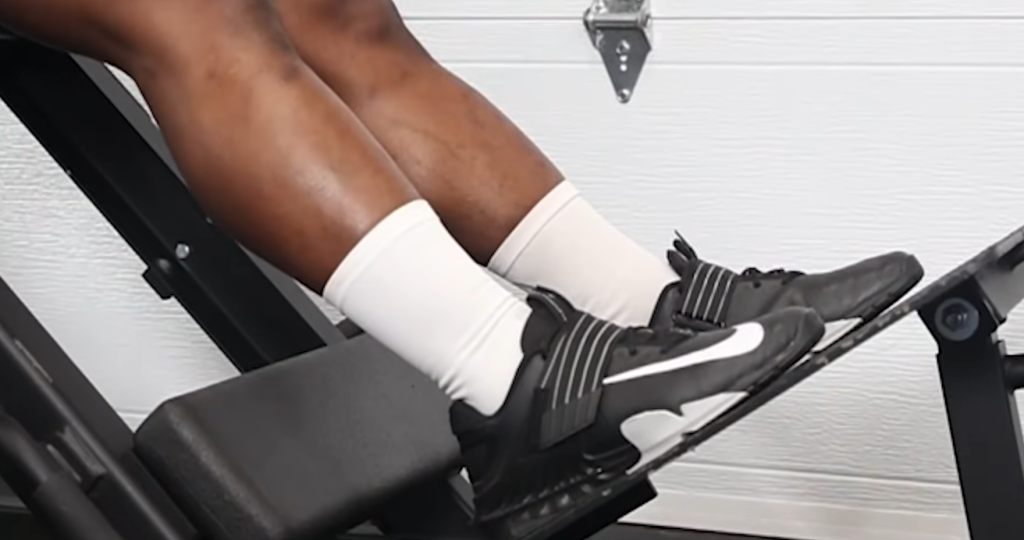
Top 20 Hack Squat Variations and How to Perform Them
1. Traditional Hack Squat
To perform a traditional hack squat, stand with your feet shoulder-width apart and place a barbell behind you on your shoulders. Keep your chest up, engage your core, and slowly lower down into a squat position. Push through your heels to return to the starting position.
2. Single Leg Hack Squat
To challenge your balance and stability, try performing the hack squat on one leg. Hold onto a wall or sturdy object for support if needed.
3. Narrow Stance Hack Squat
By placing your feet closer together in a narrow stance, you can target your quads even more during the hack squat.
4. Wide Stance Hack Squat
Conversely, a wider stance will target your glutes and hamstrings more during the hack squat.
5. Pause at the Bottom Hack Squat
To increase time under tension and really work your muscles, pause for a few seconds at the bottom of each rep during the hack squat.
6. Explosive Jump Hack Squat
Add plyometric power to your hack squat by exploding up from the bottom position into a jump.
7. Hack Squat with Resistance Bands
Place resistance bands around your knees or ankles during the hack squat to add an extra challenge and engage your muscles in a different way.
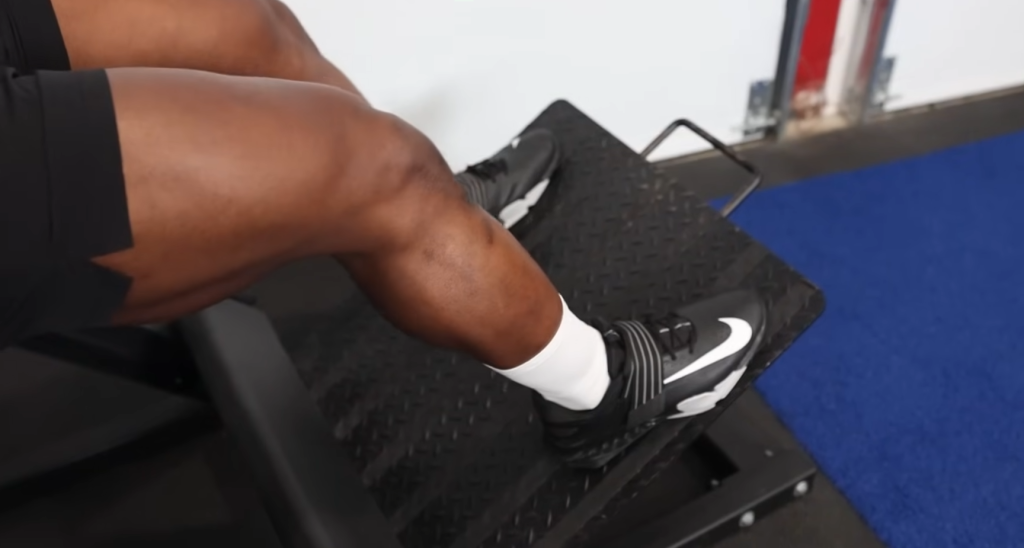
8. Sumo Stance Hack Squat
Take inspiration from sumo wrestlers and try a wider, more turned-out stance during the hack squat to target your inner thighs.
9. Hack Squat with Dumbbells
If you don’t have access to a barbell, try holding dumbbells at your sides while performing the hack squat for an equally effective workout. [4]
10. Bulgarian Split Squat Hack Squat
Place one foot on a bench or box behind you and perform the hack squat with the other leg, targeting one side at a time.
11. Overhead Hack Squat
To target your shoulders and core in addition to your legs, hold a weight plate above your head while performing the traditional hack squat.
12. Front Squat Hack Squat
Instead of placing the barbell behind your shoulders, try holding it in front of your body for a different variation on the traditional hack squat.
13. Goblet Hack Squat
Hold a weight plate or kettlebell at chest level while performing the hack squat to engage your core and upper body muscles even more.
14. Deficit Hack Squat
Perform the hack squat on a platform or step to increase your range of motion and challenge your muscles.
15. Negative Hack Squat
Try lowering down slowly and controlling during the eccentric phase of the hack squat, focusing on the negative portion of the movement for even more muscle activation.
16. Partner-Assisted Hack Squat
To add a fun and challenging twist to the hack squat, have a partner provide resistance by pulling on a resistance band attached to the barbell as you lower down.
17. Pistol Hack Squat
For an advanced variation, try performing the hack squat on one leg while holding onto a weight for added resistance. This will also challenge your balance and stability. [5]
18. Incline Hack Squat
Place a bench or incline board behind you and position the barbell on your shoulders while performing the hack squat to target your upper thighs and glutes even more.

19. Crossover Step Hack Squat
Step one foot behind the other and perform a traditional hack squat with the barbell on your shoulders to target your glutes and inner thighs in a different way.
20. Slow Negative Hack Squat
Slow down the entire movement, not just the lowering phase, by performing the hack squat at a much slower pace. This is a great way to really focus on proper form and muscle control.
By incorporating these variations into your workout routine, you can target different muscles and add variety to your hack squat exercise. Remember to always maintain proper form and listen to your body, adjusting the weight and difficulty level as needed. Hack squats are a great way to build strong, toned legs and can be adapted for all fitness levels. Keep pushing yourself and you’ll see progress in no time!
Hack Squats Alternatives
Aside from the traditional hack squat, there are several other exercises that can target similar muscle groups and provide a great lower body workout. Some alternatives to consider include:
1. Barbell Squats
Similar to the traditional hack squat, barbell squats target your quadriceps, hamstrings, glutes, and core. However, they also engage other leg muscles such as your calves and adductors, making them a more well-rounded lower body exercise. To perform barbell squats:
- Start with your feet shoulder-width apart, toes pointed slightly outward.
- Place the barbell on your upper back, resting it on your traps.
- Keeping your chest up and core engaged, bend at the knees and hips to lower yourself down into a squat.
- Lower until your thighs are parallel to the ground, then push through your heels to stand back up.
2. Goblet Squats
Goblet squats are a great alternative for those who struggle with balance or have difficulty performing barbell squats. This exercise targets similar muscle groups as hack squats, but also places more emphasis on your core and upper back. To perform goblet squats:
- Hold a dumbbell or kettlebell in front of your chest, with your elbows pointing down.
- Keep your feet shoulder-width apart and toes pointed slightly outward.
- Lower into a squat by bending at the knees and hips, while keeping your torso upright.
- Push through your heels to stand back up.
3. Bulgarian Split Squats
Bulgarian split squats are a challenging exercise that targets your quadriceps, hamstrings, and glutes while also improving balance and stability. To perform Bulgarian split squats:
- Stand in front of a bench or elevated surface with one foot on top.
- Keeping your chest up and core engaged, lower into a lunge by bending at the knees and hips.
- Lower until your back knee is almost touching the ground, then push through your front heel to stand back up.
- Repeat for desired number of reps, then switch legs.
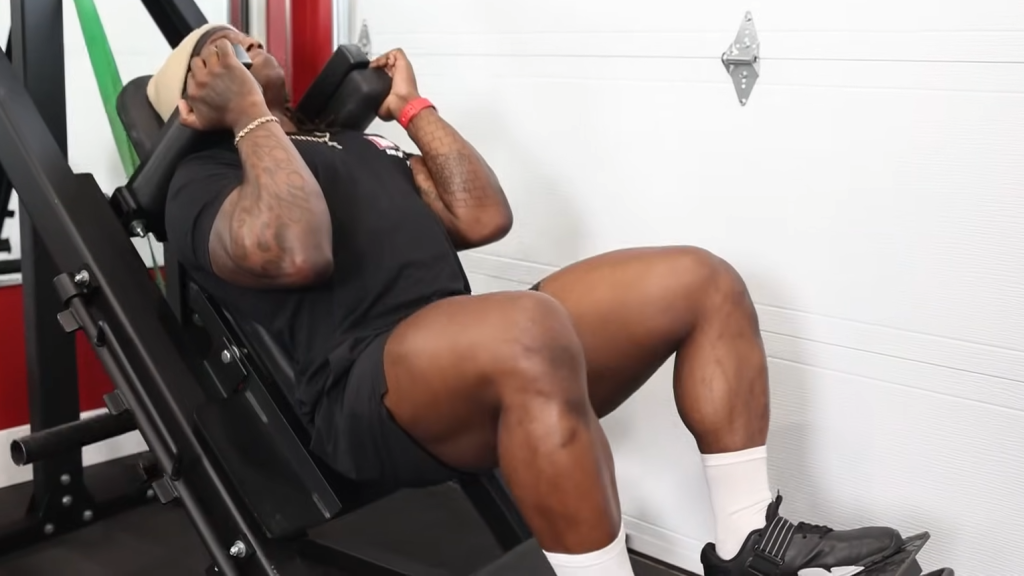
4. Leg Press
The leg press machine is a popular alternative to hack squats, as it also targets the quadriceps, hamstrings, and glutes. This exercise also allows you to lift heavier weights, making it a great option for building strength. To perform leg press:
- Sit on the machine with your feet shoulder-width apart on the footpad.
- Push through your heels to extend your knees and hips, lifting the weight up.
- Lower until your knees are at a 90-degree angle, then push back up.
- Repeat for desired number of reps. [6]
FAQs
What are hack squats?
Hack squats are a lower body exercise that specifically target your quadriceps, hamstrings, and glutes. They can be performed with a barbell or on a hack squat machine.
Are hack squats necessary for leg development?
No, there are many other exercises that can effectively target your legs and provide a challenging workout. Hack squats may be beneficial for some individuals, but they are not a necessary component of leg development. It’s important to find exercises that work best for your body and fitness goals.
How do I know which alternative is right for me?
It’s important to consult with a trainer or physical therapist to determine which exercises are best suited for your body and any specific limitations or injuries you may have. It’s also important to listen to your body and adjust as needed. Trying different alternatives and finding what works best for you will ultimately lead to the most effective and enjoyable workout routine.
What muscles do hack squats target?
Hack squats target your quadriceps, hamstrings, and glutes primarily, but also engage other leg muscles such as your calves and adductors to a lesser extent. It’s important to have a well-rounded lower body workout to ensure all muscle groups are being targeted. So, it is better to switch between different exercises rather than focusing on one particular exercise.
How does the hack squat differ from a traditional squat?
The hack squat and traditional squat both target similar muscle groups, but the difference lies in the angle of your body. In a traditional squat, your torso is more upright while in a hack squat, your torso is at a diagonal angle. This slight variation can change which muscles are targeted more intensely.
How to perform a hack squat correctly?
To perform a hack squat correctly:
- Start with your feet shoulder-width apart, toes pointed slightly outward.
- Stand on the platform and position your shoulders under the shoulder pads.
- Keep your chest up and core engaged as you bend at the knees and hips to lower yourself down into a squat.
- Lower until your thighs are parallel to the ground, then push through your heels to stand back up.
- Make sure to keep your knees in line with your toes and avoid locking out your knees at the top of the movement.
So, maintaining proper form is crucial for performing a hack squat correctly.
Can beginners perform hack squats?
While hack squats can be a challenging exercise, beginners can still perform them with proper form and appropriate weight. It’s important to start with lighter weights and focus on technique before increasing the weight. Alternatives such as goblet squats or leg presses may be better suited for beginners until they build up strength and stability.
Are hack squats safe?
Like any exercise, it’s important to use proper form and listen to your body when performing hack squats. If you have any existing injuries or limitations, it may be best to consult with a trainer or physical therapist before attempting hack squats. It’s also important to start with lighter weights and gradually increase as you build strength and confidence in the movement.
What are the benefits of hack squats?
Some potential benefits of hack squats include:
- Targeting multiple muscle groups in the lower body, making it an efficient exercise for building strength and muscle.
- Improving stability and balance through a challenging movement.
- Allowing for variations such as barbell or machine hack squats to target different areas of the legs.
- Can be performed with heavier weights, leading to potential strength gains.
- Can potentially improve athletic performance in sports that require lower body strength and power.
How often should I do hack squats?
The frequency of performing hack squats may vary depending on your fitness goals and overall workout routine. Generally, 2-3 times a week is recommended for strength building, but it’s important to listen to your body and avoid overtraining. Including variety in your lower body exercises can also be beneficial for preventing plateaus and targeting different muscle groups.
Can I do hack squats at home?
While hack squat machines may not be available in most home gyms, the exercise can still be performed with a barbell or dumbbells. Goblet squats or Bulgarian split squats are also effective alternatives that require minimal equipment and can be done at home.
What variations of hack squats can I try?
Some variations of hack squats include:
- Barbell hack squat: Instead of using a machine, use a barbell behind your legs and perform the movement as usual.
- Dumbbell hack squat: Similar to the barbell version, but using dumbbells for added challenge and variation.
- Single-leg hack squat: Perform the movement with one leg at a time, using a bench or step to elevate your non-working leg.
- Machine hack squat: Using a machine specifically designed for hack squats can provide a different angle and range of motion.
What are some tips for a successful hack squat?
Some tips for performing a successful hack squat include:
- Keep your chest up and core engaged throughout the movement.
- Avoid rounding your back or locking out your knees at the top of the movement.
- Start with lighter weights and focus on proper form before increasing weight.
- Incorporate different variations to target different muscle groups and prevent plateaus.
Conclusion
It is important to note that hack squats should not be done in isolation, as part of a well-rounded workout routine. Just like any other exercise, it is important to warm up properly before attempting hack squats. This can include dynamic stretches and foam rolling to loosen up the muscles.
In terms of equipment, hack squats can be performed using a hack squat machine or with a barbell and squat rack. Both methods provide similar benefits, but using a hack squat machine may be more beginner-friendly as it helps stabilize the weight.
Proper form is essential when performing hack squats to avoid injury. It is important to keep your feet shoulder-width apart and maintain a neutral spine throughout the movement. Focus on driving through your heels and engaging your core and glutes to lift the weight.
As with any exercise, it is important to listen to your body and adjust accordingly. If you experience any pain or discomfort, it may be a sign that your form needs adjusting or that you are using too much weight. Always start with lighter weights and gradually increase as you become more comfortable with the movement.
Remember to always consult with a certified trainer or fitness professional before attempting any new exercises or making changes to your workout routine. They can provide personalized guidance and ensure that you are performing hack squats safely and effectively.
In conclusion, adding hack squats to your fitness regimen can be a great way to strengthen your lower body and achieve your fitness goals. With proper form, equipment, and consistency, you can reap the many benefits of this challenging yet rewarding exercise. So grab some weights and give hack squats a try – your glutes, quads, and hamstrings will thank you! So why wait? Get to the gym and start hacking away for stronger legs! Remember, consistency is key when it comes to any workout routine, so make sure to incorporate hack squats regularly into your leg day routine to see results. With dedication and perseverance, you can master the hack squat and take your fitness journey to new heights.
Useful Video: Hack Squat | Exercise Guide
References:
- https://www.shape.com/fitness/tips/how-do-hack-squats-machine
- https://www.healthline.com/health/fitness-exercise/hack-squat
- https://www.menshealth.com/fitness/a28133625/hack-squat/
- https://www.muscleandstrength.com/exercises/hack-squat.html
- https://www.womenshealthmag.com/uk/fitness/strength-training/a44722071/hack-squat/
- https://breakingmuscle.com/hack-squat/

